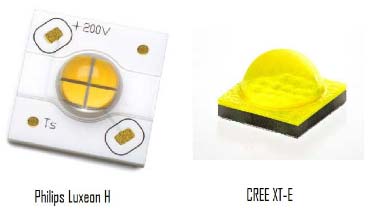Design Note DN05055/D
October 2013
High voltage LEDs are becoming more popular and are now available from multiple LED manufacturers such as CREE and Philips-Lumileds. These package LEDs may have typical forward voltages ranging from 24 to >200 V.
- Device: NCP1075 + NCP4328A
- Application: LED Driver
- Input Voltage: 90 - 135 Vac
- Output Power: Up to 9 Watts
- Topology: Boost I/O
- Isolation: Non-isolated
The development of these types of LEDs has been driven in part by the desire to improve the power conversion from the AC mains voltage to the LED string voltage as well as simplifying the driver electronics. In fact in some cases they have been promoted as being "driverless" since a diode bridge and linear regulator can implement a very simple circuit. There are several drawbacks to this approach. As the LEDs are off for a portion of every line cycle when th e input voltage is below the LED forward voltage , more LED s are needed to produce the desired lumen output . In addition, the LED lamp exhibits over 100% ripple at 100/120 Hz. The impact of low frequency ripple on human performance is not a new concern in t he lighting world and there is work underway to study this effect and set acceptable guidelines for the amount of flicker in LED light sources which are more sensitive since there is no optical persistence as is found in filament lamps.
If the LED string can be configured such that the forward voltage VF is greater than the peak AC voltage, this opens the door to use a boost topology to drive the LEDs. The output voltage must be higher than the peak of the applied ac input. This implies 135 Vac2 = 191 Vdc as the x minimum LED voltage suitable for this boost converter application.
A boost converter can provide high power factor and low THD, regulate accurate current regardless of LED forward voltage and line variation, and address the ripple issue eliminating the need to design with higher quantities of LEDs (or LED area) to achieve the desired lumen output. Note that many low power LEDs can also be arranged to achieve the required high voltage which is particularly attractive to distributed light applications such as linear tube replacements.
As with many high performance LED drivers, the proposed boost converter provides a constant output current compensating for input line voltage range and variation in LED voltage including temperature variation.
Shown below are the design guidelines for this driver:
- Input range: 90-135 Vac
- Output current: 30 mA typical
- Output voltage: 220 Vdc typical
- Efficiency: >88% Power
- Factor: >0.95
- Open Load Protection
- Constant Current Output: 30 mA
- Nominal Voltage: 220 Vdc
- Maximum Voltage: 250 Vdc
- Minimum Voltage: 200 Vdc
- Typical Power Factor: 0.98
- Typical THDi: 11%
- Typical Efficiency: 90%
- Startup Time: <20 msec
Download Design Note DN 05055/D (265 Kb)

Example High Voltage LED Products